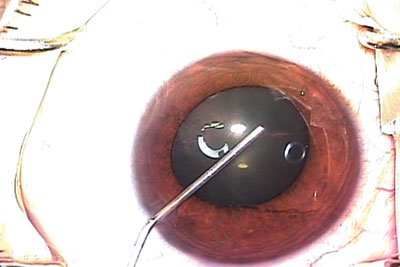Ocular anesthesia renders better, safer cataract surgery
Whatever the means — block, topical or systemic — anesthesia enhances the cataract patient's experience.
 Uday Devgan |
When patients contemplate cataract surgery, they are understandably concerned about the potential for pain during the procedure. If we can eliminate or reduce the potential for pain during and after cataract surgery, we can give patients a better experience and even improve safety by achieving akinesia or systemic sedation.
More than a century ago, ophthalmologists used topical cocaine to anesthetize eyes for cataract surgery. Our techniques have since evolved, but the principles remain the same.
Retrobulbar and peribulbar blocks
Injection of local anesthetic agents can produce both ocular anesthesia and ocular akinesia by blocking the nerve branches of cranial nerves for extraocular muscles and sensation. A retrobulbar injection is typically administered within the muscle cone behind the globe, whereas the peribulbar injection is given next to the globe. The advantage of the retrobulbar injection is that it can give a more pronounced block of the nerves, but it may come with additional risks. While globe perforation and retrobulbar hemorrhage are serious possible complications, there can be even worse, though rare, issues such as damage to the optic nerve or intradural administration of the anesthetic, which could lead to brain stem anesthesia, respiratory arrest and even death.
 Using a blunt 27-gauge cannula, preservative-free lidocaine is injected into the anterior chamber at the beginning of cataract surgery. Image: Devgan U
|
Peribulbar injections seek to limit some of these complications by keeping the sharp needle away from the orbital apex, but there is still a risk of globe perforation. In cases in which the globe is penetrated, immediate further investigation into the extent of damage must be initiated. Use of an adjunctive spreading agent such as hyaluronidase can help produce a more effective nerve block even if the anesthetic agent is not injected directly next to the nerve branches. The volume of the block should be limited to a few milliliters because a large bolus of anesthetic from a local block can induce retrobulbar pressure, which can make intraoperative complications such as iris prolapse more common.
For these anesthetic blocks, shorter-acting agents such as lidocaine are effective for brief surgeries such as cataract surgery, while longer-acting drugs such as bupivacaine may be preferred for lengthy intraocular procedures. When giving these blocks, care should be taken to avoid directly piercing the extraocular muscles close to their globe insertion to decrease the risk of muscular damage causing diplopia. The choice of needle may also play a role, with blunted tip designs preferable to decrease the risk of globe perforation.
Topical anesthesia and intracameral agents
Administering a topical anesthetic agent can avoid the serious risks of block injection techniques such as globe perforation and intradural administration; however, topical agents produce only anesthesia and not akinesia. This requires the patient to be cooperative and the surgeon to have the skill set to operate on a potentially moving target. These topical agents can be given as drops, gels or medicated pledgets placed in the conjunctival fornix.
Topical agents including tetracaine, proparacaine and lidocaine can be used to induce anesthesia of the ocular surface, with repeated surface administration of these agents producing mild intracameral concentrations. Because primary incisions for cataract surgery are often in the peripheral cornea, these agents can provide adequate anesthesia as long as other intraocular structures such as the iris are not touched. More significant intracameral levels of anesthetic agents can be produced by direct injection of anesthetic agents into the anterior chamber. It is critical to use only non-preserved anesthetic agents such as preservative-free lidocaine to prevent toxicity to delicate intraocular structures such as the corneal endothelium. Occasionally, these anesthetic agents can produce a temporary amaurosis if they come into contact with the retina.
Systemic anesthetic agents
While topical, intracameral and local block injections can be effective in producing ocular anesthesia, they are not able to reduce anxiety or induce sedation. Systemic administration of short-acting benzodiazepines and opioids are often administered in conjunction with the local anesthetic agents. These systemic drugs are most commonly given intravenously, although intramuscular, oral or even sublingual dosing is possible. Monitored anesthesia care, typically delegated to an anesthesiologist or nurse anesthetist, is critical for patients receiving these agents because of the potential for respiratory and central nervous system depression and systemic side effects.
In unusual circumstances, some patients may do best with general anesthesia. These patients include adults with severe tremors, dementia or mental retardation, and pediatric patients who cannot be expected to fully cooperate with surgery.
Anesthesia is critical for success in cataract surgery. When we achieve good ocular anesthesia and anxiolysis for our patients, we are able to deliver a better and safer surgery in a comfortable environment.
For more information:
- Uday Devgan, MD, is in private practice at Devgan Eye Surgery in Los Angeles and Beverly Hills. He can be reached at 11600 Wilshire Blvd., Suite 200, Los Angeles, CA 90025; 800-337-1969; email: devgan@gmail.com; website: www.DevganEye.com.
- Disclosure: No products or companies are mentioned that would require financial disclosure.







